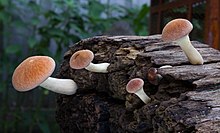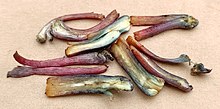Gymnopilus purpuratus
Gymnopilus purpuratus is a species of agaric fungus in the family Hymenogastraceae.[1] It grows in clusters on dead wood, tree stumps and wood chip mulch. It is widely distributed and has been recorded in Argentina, Australia, Chile, New Zealand,[2] the UK and Germany. It has a broadly convex cap covered in small dry reddish-brown scales, a stout yellow stem beneath reddish brown, wine-red to purple vertical fibres, and a thick rusty orange spore print. [citation needed]
The fruitbodies can stain greenish, blue and purple when damaged, and the species is psychoactive. A chemical analysis carried out by Jochen Gartz in 1993 found that this species contains 0.34% psilocybin, 0.29% psilocin and 0.05% baeocystin. [citation needed]
| Gymnopilus purpuratus | |
|---|---|

| |
| Scientific classification | |
| Domain: | Eukaryota |
| Kingdom: | Fungi |
| Division: | Basidiomycota |
| Class: | Agaricomycetes |
| Order: | Agaricales |
| Family: | Hymenogastraceae |
| Genus: | Gymnopilus |
| Species: | G. purpuratus
|
| Binomial name | |
| Gymnopilus purpuratus | |
| Synonyms | |
| |
Description
[edit]| Gymnopilus purpuratus | |
|---|---|
| Gills on hymenium | |
| Cap is convex or umbonate | |
| Hymenium is adnate or adnexed | |
| Stipe is bare | |
| Spore print is yellow-orange | |
| Ecology is saprotrophic | |
| Edibility is psychoactive | |

The cap ranges from 1.5 to 6 cm across, is convex to obtuse, and is reddish brown with a dry scaly surface which is sometimes cracked in age. The stem is brown-red and covered by fibers and has blue-green spots where the stem is damaged. The gills are crowded, yellow to orange, and adnexed. The stem is dusted with rusty orange spores and has a cottony scanty partial veil.[citation needed]

See also
[edit]References
[edit]- ^ "Index Fungorum - Gymnopilus purpuratus (Cooke & Massee) Singer 1955". Index Fungorum. Retrieved 27 May 2023.
- ^ "Biota of New Zealand - Maanaki Whenua Landcare Research - Gymnopilus purpuratus (Cooke & Massee) Singer 1955". Biota.of New Zealand. Retrieved 27 May 2023.
- Mushroom Observer: Name: Gymnopilus purpuratus (Cooke & Massee) Singer
- Hesler, L. R. (1969). North American species of Gymnopilus. New York: Hafner. 117 pp.
External links
[edit]![]() Media related to Gymnopilus purpuratus at Wikimedia Commons
Media related to Gymnopilus purpuratus at Wikimedia Commons
- Gymnopilus purpuratus chemical analysis
- Painting of Cooke's type specimen, Agaricus purpuratus, collected in Kew Gardens; in his Illustrations of British Fungi (Hymenomycetes), to serve as an atlas to the "Handbook of British Fungi", vol. 8 - Biodiversity Heritage Library
- ^ Guzmán-Dávalos, Laura; Mueller, Gregory M.; Cifuentes, Joaquín; Miller, Andrew N.; Santerre, Anne (2003). "Traditional infrageneric classification of Gymnopilus is not supported by ribosomal DNA sequence data". Mycologia. 95 (6): 1204–1214. doi:10.1080/15572536.2004.11833028. PMID 21149021. S2CID 3293845.
Text is available under the CC BY-SA 4.0 license; additional terms may apply.
Images, videos and audio are available under their respective licenses.
